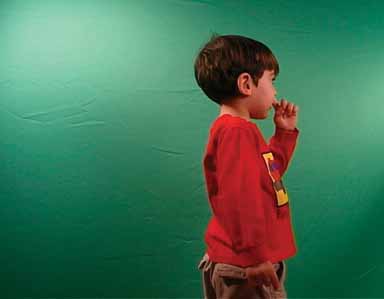Framing Images with Composites in Mind
Just as the shadows and lighting in your key shot need to match the shadows and lighting in your background, the content and framing of your foreground clip needs to work well enough with the background clip that the combination is believable. An obvious example is if you plan to composite someone into a shot on the beach, they shouldn’t be wearing a winter coat. (Unless you want to do this for effect; for example, to imply humor, irony, or someone who is crazy or doesn’t plan well.) There are also more subtle considerations, including camera angle, framing (wide shot, close up, etc.), and the placement of elements within the frame.
If you shoot an actor against a blue or green screen and then key out the background, it’s often easier to composite her into a shot if you don’t show her entire body from head to toe (Figure 5-5). Have you ever noticed that you almost never see the feet of a meteorologist when he’s standing in front of an animated weather map? Part of the reason is there’s no real reason to show a person’s shoes as he forecasts the weather, but it would also make the composite more difficult. The shot would require not only placing someone in front of a green or blue screen background, but placing him on a blue or green floor as well, and then lighting everything without producing shadows—no easy task.

Figure 5-5. We shot our actor ...
Get DV Filmmaking now with the O’Reilly learning platform.
O’Reilly members experience books, live events, courses curated by job role, and more from O’Reilly and nearly 200 top publishers.

